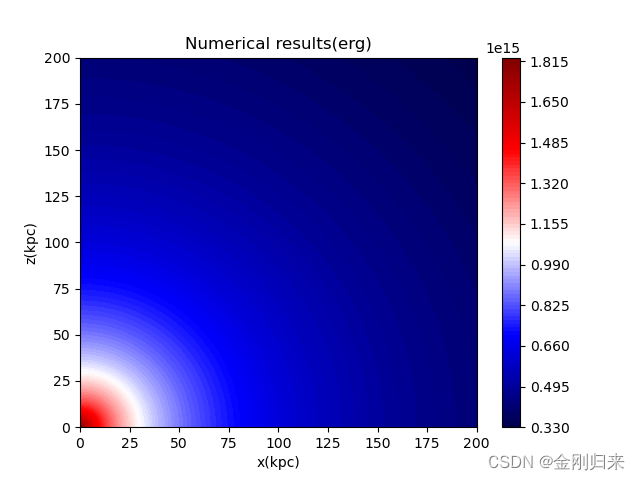写了一个柱坐标下多重网格法解泊松方程的code,外边界采用的是第一类边界条件,直接用解析解赋值,内边界需要注意的是在x=0的转轴上面有奇点。
柱坐标下泊松方程形式为
当x趋向于0时,
将方程离散化,其中第三项采用中心差分格式。
开始采用了有残差的多重网格形式,一直不收敛,后来索性残差去掉了,收敛的还可以。
import math
import numpy as np
import matplotlib.pyplot as plt
from scipy import interpolate
import time
def coarsen(x_fine, y_fine, phi_fine):# Lagrange type interpolation, two order
x2 = np.linspace(x_fine[0],x_fine[-1],int(x_fine.size/2))
y2 = np.linspace(y_fine[0],y_fine[-1],int(y_fine.size/2))
f = interpolate.interp2d(x_fine, y_fine, phi_fine, kind='cubic')#{‘linear’, ‘cubic’, ‘quintic’}
phi2 = f(x2,y2)
return phi2, x2, y2
def fine(x_coarse, y_coarse, phi_coarse):# Lagrange type interpolation, two order
x2 = np.linspace(x_coarse[0],x_coarse[-1],int(x_coarse.size*2))
y2 = np.linspace(y_coarse[0],y_coarse[-1],int(y_coarse.size*2))
f = interpolate.interp2d(x_coarse, y_coarse, phi_coarse, kind='cubic')#{‘linear’, ‘cubic’, ‘quintic’}
phi2 = f(x2,y2)
return phi2, x2, y2
def Relax2( b, phi, x, z,leveli):
omega = 1.95
ite = 10*3**leveli # the iteration time, you can set by other condition
k = 0
h_r = x[1]-x[0]
h_z = z[1]-z[0]
while(k<ite): #控制迭代次
print('relax,k and leveli=',k,leveli)
for i in range(0,x.size-1):
for j in range(0, z.size-1):
phi_ji = np.copy(phi[j,i])
dr_2 = h_r*h_r # dr^2
dz_2 = h_z*h_z
if (i!=0 and j!=0):# the inner boundary
a1 = -2/dr_2-2/dz_2
a2 = 1/dr_2+1/x[i]/2/h_r
a3 = 1/dr_2-1/x[i]/2/h_r
a4 = 1/dz_2
a5 = 1/dz_2
phi[j,i] = (1.-omega)*phi_ji-omega/a1*(a2* (phi[j,i+1])+a3* (phi[j,i-1])+a4* (phi[j+1,i])+a5* (phi[j-1,i])-b[j,i])
continue
elif (i!=0 and j==0):
a1 = -2/dr_2-2/dz_2 #factor to u[j,i]
a2 = 1/dr_2+1/x[i]/2/h_r#factor to u[j,i+1]
a3 = 1/dr_2-1/x[i]/2/h_r #factor to u[j,i-1]
a4 = 2/dz_2 #factor to u[j+1,i]
phi[j,i] = (1.-omega)*phi_ji-omega/a1*(a2* (phi[j,i+1])+a3* (phi[j,i-1])+a4* (phi[j+1,i])-b[j,i])
continue
elif (i==0 and j!=0):#z axis
a1 = -4/dr_2-2/dz_2
a2 = 4/dr_2
a3=1/dz_2
a4=1/dz_2
phi[j,i] = (1.-omega)*phi_ji-omega/a1*(a2* (phi[j,i+1])+a3* (phi[j-1,i])+a4* (phi[j+1,i])-b[j,i])
continue
else:
a2 = 4/dr_2
a3 = 2/dz_2
a1 = -1*a2-a3
phi[j,i] = (1.-omega)*phi_ji-omega/a1*(a2* (phi[j,i+1])+a3* (phi[j+1,i])-b[j,i])
k = k+1
return phi
def residual(b, phi, x, z):
res = np.zeros((z.size,x.size),dtype=float)
for i in range(0,x.size-1):
for j in range(0,z.size-1):
dr_2 = h_r*h_r # dr^2
dz_2 = h_z*h_z
if (i==0 and j==0):
res[j,i] =b[0,0]-4*(phi[0,1]-phi[0,0])/dr_2-2*(phi[1,0]-phi[0,0])/dz_2
elif (i!=0 and j==0):
a1 = -2/dr_2-2/dz_2 #factor to u[j,i]
a2 = 1/dr_2+1/x[i]/2/h_r#factor to u[j,i+1]
a3 = 1/dr_2-1/x[i]/2/h_r #factor to u[j,i-1]
a4 = 2/dz_2 #factor to u[j+1,i]
res[j,i] = b[j,i]-a1*phi[j,i]-a2*phi[j,i+1]-a3*phi[j,i+1]-a4*phi[j+1,i]
elif (i==0 and j!=0):#z axis
a1 = -4/dr_2-2/dz_2
a2 = 4/dr_2
a3=1/dz_2
a4=1/dz_2
res[j,i]= b[j,i]-a1*phi[j,i]-a2*phi[j,i+1]-a3*phi[j+1,i]-a4*phi[j-1,i]
else:
a1 = -2/dr_2-2/dz_2
a2 = 1/dr_2+1/x[i]/2/h_r
a3 = 1/dr_2-1/x[i]/2/h_r
a4 = 1/dz_2
a5 = 1/dz_2
res[j,i] = b[j,i]-a1*phi[j,i]-a2*phi[j,i+1]-a3*phi[j,i-1]-a4*phi[j+1,i]-a5*phi[j-1,i]
return res
def bij(x,z):
b0 = density_nfw(x,z)
return b0
def density_nfw(x,z): #density of the NFW dark matter potential
rho0_nfw =1# 0.00854*1e9#M0/Kpc^3
rh = 19.6 #Kpc
rho=np.zeros((z.size,x.size))
for j in range(0,z.size):
for i in range(0,x.size):
r = math.sqrt(x[i]*x[i]+z[j]*z[j])
rrh = r/rh
if rrh<0.02:
rrh=0.02
rho[j,i] = rho0_nfw/rrh/(1+rrh)/(1+rrh)
return rho
def phi_nfw(x,z): # the analysical result
rho0_nfw=1#assum 4pi g rho=1
rh = 19.6
phi0=np.zeros((z.size,x.size),dtype=float)
for j in range(0,z.size):
for i in range(x.size):
r = math.sqrt(x[i]*x[i]+z[j]*z[j])
rrh = r/rh
if rrh<0.02:
rrh=0.02
phi0[j,i] = -1*rh* rh*math.log(1+rrh)/rrh
return phi0
def MG2( b,phi, x,z):
h_r0 = x[1]-x[0]
h_z0 = z[1]-z[0]
vh = Relax2(b, phi, x, z,1)
total_level=int(math.log(x.size, 2)-1)
t = 0
while (t <1): # number of V circles, here is 1
for i in range(1, total_level):
k = i
v2h,x2,z2 = coarsen(x,z,vh)
b2 = bij(x2,z2)
vh = Relax2(b2, v2h, x2, z2, k)
x = x2
z = z2
for i in range(1,total_level):
v2h,x2,z2 = fine(x,z,vh)
b2=bij(x2,z2)
vh0 = Relax2(b2, v2h, x2, z2, k)
vh = vh0
x = x2
z = z2
k=k-1
t = t+1
print('Vtime=',t)
return vh
'''
def MG2( b,phi, x,z):
h_r0 = x[1]-x[0]
h_z0 = z[1]-z[0]
vh0 = Relax2(b, phi, x, z,1)
rh = residual(b, phi, x, z)# residual
eh0 = np.zeros(rh.shape,dtype = float)
eh = Relax2(rh, eh0, x,z,1)
vh = vh0+eh
rh = residual(b, vh, x, z)
t = 0
while ((np.max(rh) > 1e-2) and (t <1)):
for i in range(1,5):
k = i
# r2h,x2,z2 = coarsen(x,z,rh) # residual to fine grid
v2h,x2,z2 = coarsen(x,z,vh)
b2=bij(x2,z2)
vh0 = Relax2(b2, v2h, x2, z2, k)
rh = residual(b2, vh0, x2, z2)
eh = Relax2(rh, eh0, x,y,5)
vh = vh0+eh
eh0 = np.zeros(rh.shape,dtype = float)
e2h0 = np.zeros(r2h.shape,dtype = float)
e2h = Relax2(r2h, e2h0,x2,z2,k)
phi = v2h+e2h
b = bij(x2,z2)
vh = Relax2(b, phi, x2,z2,k)
rh = residual(b, vh, x2,z2)
x = x2
z = z2
for i in range(1,5):
k = 6-i
r2h,x2,z2 = fine(x,z,rh) # residual to fine grid
e2h0 = np.zeros(r2h.shape,dtype = float)# initiate the err
e2h = Relax2(r2h, e2h0, x2,z2,k) #calculate err
v2h,x2,z2= fine(x,z,vh) #to fine grid
phi = v2h+e2h # update phi
b = bij(x2,z2) # calculate b on this level
vh = Relax2(b, phi, x2,z2,k) # calculate vh again with updated phi
rh = residual(b, vh, x2,z2) #calculate residual
x = x2
z = z2
t = t+1
print('Vtime=',t)
return vh
'''
'''
def MG2(b, phi, x, z):
h_r = x[1]-x[0]
y_r = z[1]-z[0]
vh = Relax2(b, phi, x, z)
rh = residual(b, phi, x, z)# residual
i = 0
while (i<10):
#print(phi)
r2h,x2 ,z2= coarsen(x,z,rh) # residual to coarse grid
h_r2=x2[1]-x2[0]
h_z2=z2[1]-z2[0]
e2h0 = np.zeros((z2.size,x2.size),dtype = float)
e2h = Relax2(r2h, e2h0,x2,z2)
print(e2h.shape)
eh,x, z = fine(x2,z2,e2h)
print(vh.shape,eh.shape)
v1h = vh+eh
h_r = x[2]-x[1]
h_z = z[1]-z[0]
phi = Relax2(b, v1h, x,z )
vh = v1h
rh = residual(b, vh, x,z)
i = i+1
print(i)
return phi
'''
def initiate():
time_start = time.time()
n_x_grid =128
n_z_grid=128
xs = 0.
xe =200 # in kpc
zs=0.
ze=200
x=np.linspace(xs,xe,n_x_grid)
z=np.linspace(zs,ze,n_z_grid)
phi = np.ones((z.size,x.size), dtype=float)
phi2 = phi_nfw(x,z)
phi[-1,:] = (phi2[-1,:])
phi[:,-1] = (phi2[:,-1])
b = density_nfw(x,z)
h_r=x[1]-x[0]
h_z=z[1]-z[0]
'''
vh0 = Relax2(b, phi, x, z,5)
rh = residual(b, phi, x, z)# residual
eh0 = np.zeros(rh.shape,dtype = float)
eh =0# Relax2(rh, eh0, x,z,5)
vh = vh0+eh
#rh = residual(b, vh, x,z)
'''
result = MG2( b, phi, x, z) # solve the equation
grav=6.67e-8 #cgs
m0=1.989e33
kpc=3.086e21
rho_halo0=0.00854*1e9*m0/kpc#a^2里面有个kpc的平方
potential = 4*math.pi*grav*rho_halo0*result
phi_error = 4*math.pi*grav*rho_halo0*(phi2-result)
time_end = time.time()
#print(result.shape)
time_c= time_end - time_start #运行所花时间
print('time cost', time_c, 's')
return potential,phi_error, x, z
def plot(x, z, result,name):
print(name)
plt.figure(1)
plt.contourf(x,z,result ,100,cmap='seismic')
plt.colorbar()
plt.title(name)
plt.xlabel('x(kpc)')
plt.ylabel('z(kpc)')
plt.savefig(name+'.png')
plt.show()
plt.close()
return 0
def plot1d(x,phi,name):
print(name)
plt.figure(1)
plt.plot(x,phi)
plt.title(name)
plt.xlabel('x(kpc)')
plt.ylabel('phi')
plt.savefig(name+'.png')
plt.show()
plt.close()
return 0
potent, err, x, z = initiate()
plot(x,z, potent,'Numerical results(erg)')
plot(x,z,err,'error')
plot1d(x,err[0,:],'err1d')





















 829
829











 被折叠的 条评论
为什么被折叠?
被折叠的 条评论
为什么被折叠?








